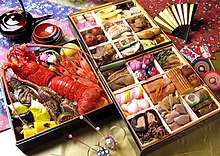
Back مطبخ ياباني Arabic Gastronomía de Xapón AST Yaponiya mətbəxi AZ Ajengan Jepang BAN Pagkakan nin Hapon BCL Японская кухня BE Японска кухня Bulgarian জাপানী রন্ধনশৈলী Bengali/Bangla Gastronomia del Japó Catalan Japonská kuchyně Czech

Japanese cuisine encompasses the regional and traditional foods of Japan, which have developed through centuries of political, economic, and social changes. The traditional cuisine of Japan (Japanese: washoku) is based on rice with miso soup and other dishes; there is an emphasis on seasonal ingredients. Side dishes often consist of fish, pickled vegetables, and vegetables cooked in broth. Seafood is common, often grilled, but also served raw as sashimi or in sushi. Seafood and vegetables are also deep-fried in a light batter, as tempura. Apart from rice, a staple includes noodles, such as soba and udon. Japan also has many simmered dishes, such as fish products in broth called oden, or beef in sukiyaki and nikujaga.
Historically influenced by Chinese cuisine, Japanese cuisine has also opened up to influence from Western cuisines in the modern era. Dishes inspired by foreign food—in particular Chinese food—like ramen and gyōza, as well as foods like spaghetti, curry and hamburgers, have been adapted to Japanese tastes and ingredients. Traditionally, the Japanese shunned meat as a result of adherence to Buddhism, but with the modernization of Japan in the 1880s, meat-based dishes such as tonkatsu and yakiniku have become common. Since this time, Japanese cuisine, particularly sushi and ramen, has become popular globally.
In 2011, Japan overtook France to become the country with the most 3-starred Michelin restaurants; as of 2018[update], the capital of Tokyo has maintained the title of the city with the most 3-starred restaurants in the world.[1] In 2013, Japanese cuisine was added to the UNESCO Intangible Heritage List.[2]
- ^ Demetriou, Danielle (October 19, 2011). "Japan relishes status as country with most three-starred Michelin restaurants". The Daily Telegraph. ISSN 0307-1235. Archived from the original on January 11, 2022. Retrieved January 15, 2019.
- ^ "Japanese cuisine added to Unesco 'intangible heritage' list". BBC News. December 5, 2013.